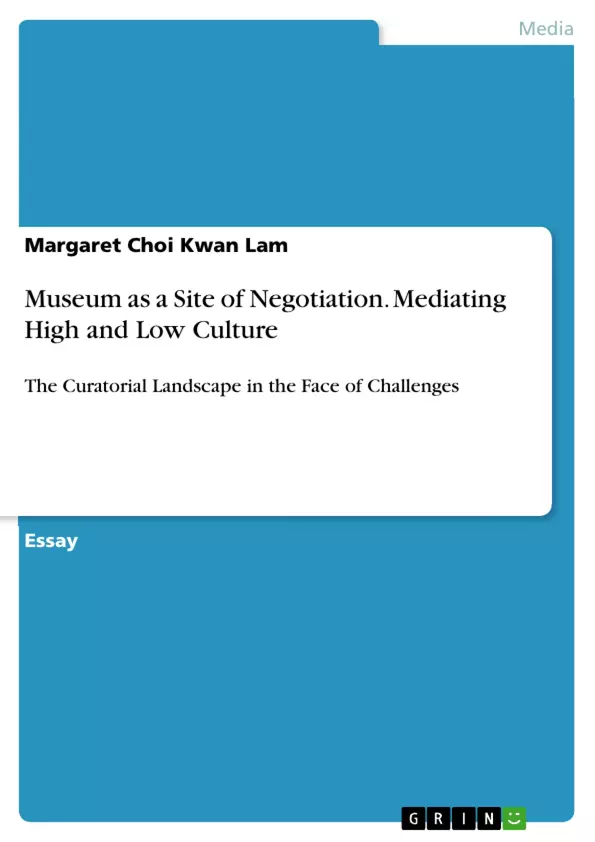Between high and low culture, there was once a deep and wide gulf. The clear division was never a natural phenomenon, but rather a result of a cultural act. Throughout the history, the conflict in-between had taken a long way to resolve and the whole subject matter had caused marathon debates among modern cultural critics. Museums, as institutions once with absolute powers in its operation, had been forced to face a worldwide revolution. There were much more mixed emotions towards mass culture - questioning, inquiries, struggles, seduction and temptation at the same time - which constituted a push-and-pull situation. What were museums for? Was it a time for museums to reconsider their role and democratize themselves? What kind of resistance and temptation had museums encountered? To what extent would curators act as pioneers to eliminate the gap in-between taste diversity in art and design? These questions are worthwhile to take a look into. This essay aims to unveil the ways curators liberated themselves from a singular-voiced museum practice, which resulted in revolutions of curatorial models that incorporated multiple voices. Cases include: High and Low: Modern Art and Popular Culture (1990-91, MOMA), The People’s Show (1990, Walsall Museum and Art Gallery) and Postmodernism: Style and Subversion 1970-1990 (2011, V&A).
Inhaltsverzeichnis (Table of Contents)
- Introduction
- Discussion
- Section 1
- Critique on Singular-Voiced High Culture: Museums as Shrines
- Section 2
- When Museums Met Mass Culture
- Threat and Temptation of Mass Culture: Mass Critics' Views
- Design as Merely Reproductions? Or a Transformative Force?
- What are museums for? A Turning Point: Revolutionizing Curating Modes
- Section 3
- Case Studies
- High and Low: Modern Art and Popular Culture (MOMA, 1990-91)
- The People's Show (Walsall Museum and Art Gallery, 1990)
- Postmodernism: Style and Subversion 1970-1990 (V&A, 2011)
- Conclusion
Zielsetzung und Themenschwerpunkte (Objectives and Key Themes)
This essay explores how museums responded to the growing influence of mass culture on high culture. It examines how curators moved away from traditional museum practices that prioritized high culture and embraced new approaches that incorporated diverse voices and perspectives.
- The historical relationship between high and low culture, from the traditional view of high culture as "the best that has been said and thought" to the emergence of mass culture as a challenging force.
- The impact of mass culture on museums as institutions and the challenges they faced in navigating this new landscape.
- The evolution of curatorial models as a response to the changing cultural landscape, with a focus on the democratization of museum practices and the inclusion of diverse perspectives.
- Case studies that demonstrate the implementation of new curatorial models, showcasing how museums incorporated elements of mass culture and embraced a more inclusive approach.
- The significance of these changes in shaping the future of museum culture.
Zusammenfassung der Kapitel (Chapter Summaries)
The essay begins by outlining the historical tension between high and low culture, highlighting the traditional view of high culture as superior and the emergence of mass culture as a potential threat. It then explores the impact of mass culture on museums, highlighting the challenges they faced in maintaining their authority and relevance in a rapidly changing cultural landscape.
The essay further delves into the evolving curatorial models that emerged as a response to these challenges, focusing on the transition from traditional practices that prioritized high culture to more inclusive approaches that incorporated diverse voices and perspectives.
Finally, the essay showcases three case studies: "High and Low: Modern Art and Popular Culture" (MOMA, 1990-91), "The People's Show" (Walsall Museum and Art Gallery, 1990), and "Postmodernism: Style and Subversion 1970-1990" (V&A, 2011). These case studies demonstrate the implementation of new curatorial models, highlighting how museums incorporated elements of mass culture and embraced a more inclusive approach.
Schlüsselwörter (Keywords)
The essay focuses on the relationship between high and low culture, the evolution of museum curatorial practices, and the impact of mass culture on the institution of museums. Key concepts include the democratization of museums, the inclusion of diverse perspectives, and the role of the curator as a mediator between high and low culture.
- Citation du texte
- Margaret Choi Kwan Lam (Auteur), 2013, Museum as a Site of Negotiation. Mediating High and Low Culture, Munich, GRIN Verlag, https://www.grin.com/document/266355



